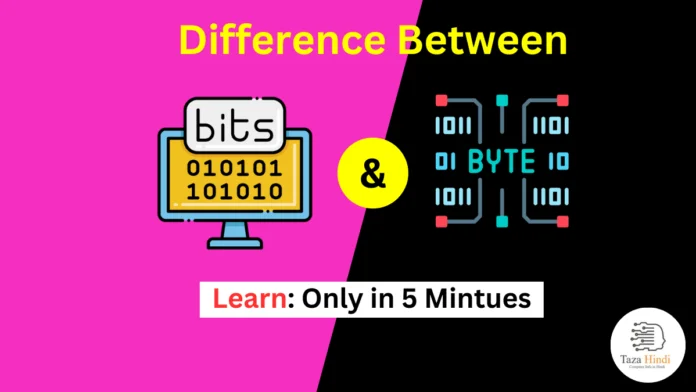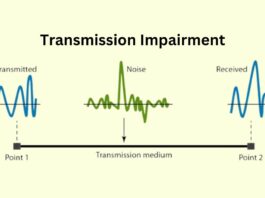In the world of computing and digital information, two fundamental units are often encountered: the bit and the byte. While they may sound similar, they have distinct meanings, purposes, and applications. In this article provide a comprehensive tutorial about bits and bytes, their origins, purposes, how they are used to represent data, and then explain in detail what are the difference between Bit and Byte.
What is Bit?
A bit, short for “binary digit,” is the most basic unit of information in computing. It represents the smallest possible piece of data and has only two possible values: 0 or 1. The term “bit” was coined in 1948 by Claude Shannon, a mathematician and computer scientist, to describe the fundamental building blocks of digital communication systems.
Origin of the term Bit
The term “bit” is derived from a combination of the words “binary” and “digit.” It reflects the binary nature of digital information, where data is represented using only two digits: 0 and 1. Claude Shannon introduced the term in his seminal paper “A Mathematical Theory of Communication,” which laid the foundation for modern digital communication and information theory.
Purpose of Bit?
The purpose of a bit is to represent the most basic unit of information in computing. It serves as the building block for storing, processing, and transmitting data in digital systems. Bits are used to encode and convey information, enabling the representation of numbers, characters, and other forms of data.
Also Read : Difference between Circuit Switching and Packet Switching
How bits are used to represent binary data and are the smallest unit of information?
Bits are used to represent binary data, where each bit corresponds to a binary digit. A sequence of bits can be used to represent numbers in binary form. For example, the binary number 10101 represents the decimal number 21. Additionally, bits can be used to represent the states of switches or flags, where 0 can represent “off” and 1 can represent “on.” The smallest unit of information is a single bit, which can hold one of the two possible values, 0 or 1.
Applications of bits
Bits find applications in various areas of computing and digital technology. They are essential in computer architecture, data storage, telecommunications, digital signal processing, cryptography, and many other fields. Bits are the foundation for the binary representation of data in computers, enabling the manipulation and processing of information at its most fundamental level.
What are the Uses of bits?
Bits are used in numerous ways, including:
- Data Storage: Bits are used to represent information in storage devices such as hard drives, solid-state drives, and memory chips. Data is stored in binary form, with each bit representing the on/off state of a storage element.
- Network Communication: Bits are used to transmit data over networks. Information is broken down into packets, each consisting of a sequence of bits, which are sent from one device to another through network connections.
- Digital Representation: Bits are used to represent and process digital media such as images, audio, and video. Each element of the media is encoded into a binary representation using bits, allowing for storage, transmission, and manipulation.
- Encryption and Security: Bits play a crucial role in encryption algorithms, where they are used to perform complex mathematical operations on data to ensure secure communication and data protection.
Also Read : Difference between LAN and WAN
What is Byte?
A byte is a larger unit of information that consists of a sequence of bits. It is typically composed of 8 bits, although byte sizes can vary depending on the system architecture. The term “byte” was coined by Dr. Werner Buchholz in 1956 while working on the IBM Stretch computer project.
Purpose of Byte
The purpose of a byte is to provide a more convenient and practical unit for representing and manipulating data. Bytes allow for the storage and processing of larger quantities of information compared to individual bits. Bytes serve as a standard unit of measurement for data in most computer systems and programming languages.
How bytes are used to store and represent larger units of information ?
Bytes are used to store and represent larger units of information by grouping together multiple bits. A byte consists of 8 bits, and each bit within the byte holds a value of either 0 or 1. By combining these 8 bits, a byte can represent 256 different values (2^8). This provides a wider range of possible values compared to a single bit.
What are the Uses of bytes?
Bytes have numerous uses in computing and digital systems, including:
- Memory Allocation: Bytes are used to allocate memory in computer systems. Memory is typically measured in bytes, and programs utilize bytes to store and retrieve data during runtime.
- Character Encoding: Bytes are used to represent characters in various character encoding schemes such as ASCII (American Standard Code for Information Interchange) and Unicode. Different characters are assigned specific byte patterns, allowing for text representation and processing.
- File Storage: Bytes are used to store data in files on storage devices. File sizes are typically measured in bytes, indicating the amount of space required to store the data.
- Network Transmission: Bytes are used to transmit data over networks. Network protocols break data into packets, each consisting of a sequence of bytes. Bytes allow for efficient data transfer and ensure the accurate reconstruction of the transmitted information at the receiving end.
Also Read : Difference between IP Address and MAC Address
Relationship between bits and bytes
There is a clear relationship between bits and bytes. A byte consists of 8 bits, which means that 8 individual bits can combine to form a byte. This relationship allows for efficient storage, processing, and transmission of data. Bytes provide a higher level of abstraction compared to bits, allowing for more compact and meaningful representations of information.
Difference between Bit and Byte
While bit and byte are related, there are distinct differences between them:
| Factors | Bit | Byte |
| Size | A bit is the smallest unit of information, representing a single binary digit (0 or 1). | A byte, on the other hand, consists of 8 bits and represents a larger unit of information. |
| Capacity | A single bit can store only one piece of information (0 or 1). | A byte can store a wider range of values, providing 256 possible combinations (2^8). |
| Usage | Bits are commonly used for low-level operations, such as data manipulation, signaling, and binary calculations. | Bytes are used to represent characters, store data, and measure memory and file sizes. |
| Representation | Bits are often represented as single binary digits (0 or 1). | Bytes, on the other hand, can be represented using hexadecimal or decimal notation, making them more easily readable and understandable. |
Also Read : How to make money with Web Designing
Conclusion
Bit and byte are fundamental units of information in computing and digital systems. While bits are the smallest units, representing binary digits, bytes provide a larger and more practical unit for storing, processing, and transmitting data. Bits are used for low-level operations and individual signaling, while bytes are used for higher-level data representation and measurement. Understanding the difference between bits and bytes is essential for effective data management, encoding, and communication in the digital world.
FAQs
-
How many bits are there in a byte?
A byte consists of 8 bits.
-
Can bits be directly converted into bytes?
Yes, bits can be combined to form bytes. Eight bits make up a byte.
-
Which is larger, a bit or a byte?
A byte is larger than a bit. It consists of multiple bits grouped together.
-
Can bits and bytes be used interchangeably?
No, bits and bytes have distinct meanings and cannot be used interchangeably. They represent different units of information with varying capacities and uses.
-
Are bits and bytes used in all computer systems?
Yes, bits and bytes are fundamental units used in all computer systems to represent and process information.



